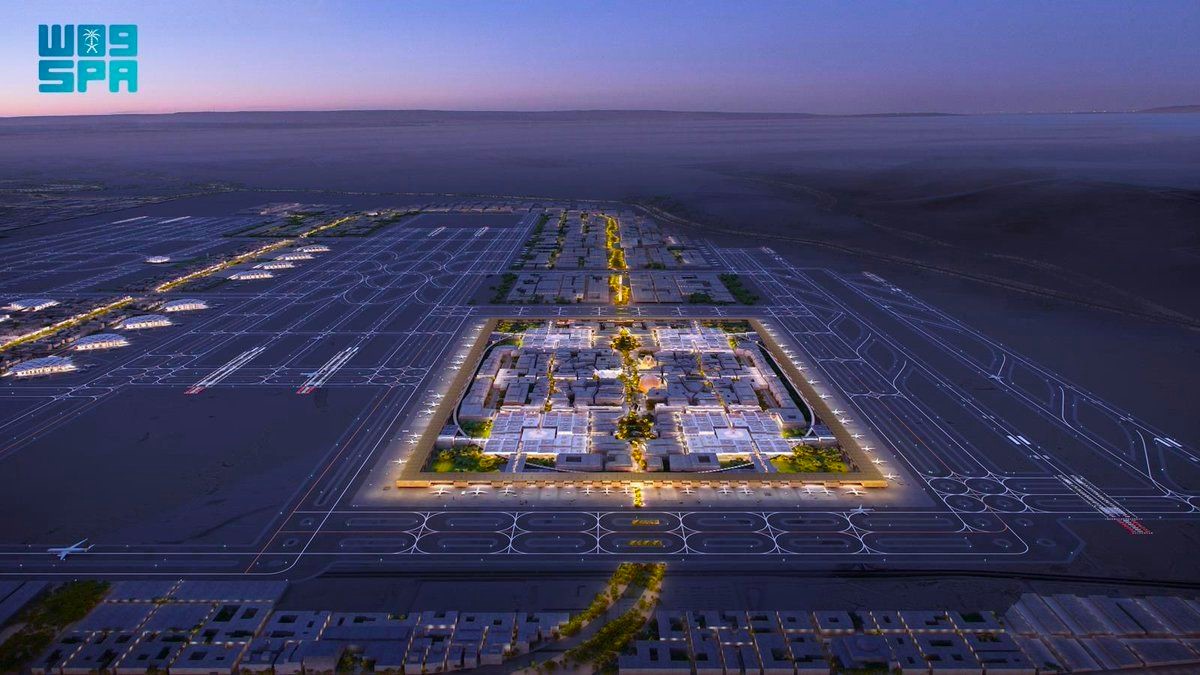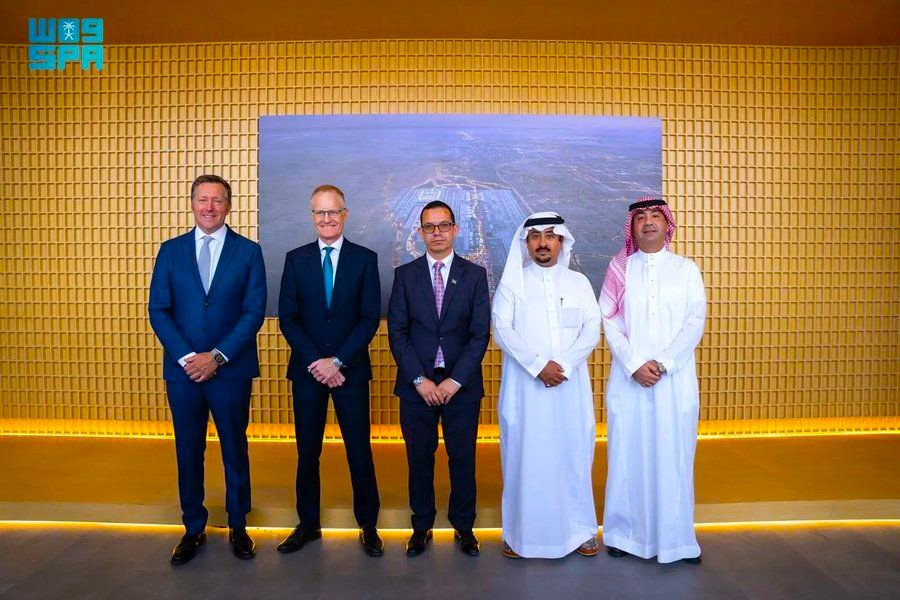


We talked about a new Cargo Airline by Saudi Arabia the other day which was revealed while the launch process for Riyadh Air is ongoing, however, now it's the turn for a new Airport, or you call it an Aerotropolis.
Riyadh is set to host an aerotropolis with the completion of King Salman International Airport, potentially becoming the world's largest upon the completion of its construction and expansion projects.
King Salman International Airport Development Company (KSIADC) has now hired experts in Foster & Partners, Jacobs Engineering, Mace, and Nera to design for the job and they will build the 57 km2, six-runway airport development in Riyadh, Saudi Arabia.
King Salman International Airport, which is a project being nourished under the Saudi Arabian government’s sovereign wealth fund Public Investment Fund (Pif), takes its baby steps starting this month.
PIF’s Vision 2030 programme of works is designed to help the country diversify its income away from oil and gas exports and includes funding for the ambitious giga-project Neom.
PIF said in a statement in year 2022:
“KSIA is expected to be one of the largest airports with an area of 57 km2 and 6 parallel runways, raising the airport's capacity to accommodate up to 120 million passengers by 2030, and 185 million passengers by 2050. In addition to 12 km² of supporting facilities, residential, recreational, shops, and logistical facilities.
“KSIA is one of the ambitious projects to support Saudi Arabia's Vision 2030 to take advantage of its strategic geographical location, as it is a link between Asia, Africa, and Europe, and makes Riyadh a global destination for transportation, trade, and tourism.”
Announcing the appointment of Jacobs, Mace and Foster & Partners, KSIADC acting CEO Marco Mejia said:
“We are committed to delivering this airport as a global benchmark, propelling Saudi Arabia's 2030 vision for Riyadh's transformation into a global hub and position Saudi Arabia as an economic powerhouse.”
“We are thrilled to welcome these industry leaders to work closely with the KSIA team. Their combined expertise will be instrumental in delivering a world-class airport that surpasses expectations and fuels regional economic prosperity.”
.jpg)
Spanning approximately 57 sq. km, the facility will feature six parallel runways and existing terminals named after King Khalid, the founder of modern Saudi Arabia. It will also include 12 sq. km of support facilities, residential and recreational areas, retail spaces, and logistics real estate.
For this to be executed, the roles have been defined for each one involved and all the named firms will work on the concept masterplan validation henceforth.
The deals with these leading firms in architecture, engineering, construction, and air traffic management aim to advance the facility’s expansion and establish it as a major hub for tourism, travel, and transportation in Riyadh and the broader region.

The architectural firm Foster & Partners said the KSIA airport masterplan “includes 12km² of, residential and recreational facilities, retail outlets, airport support facilities and other logistics real estate” and is “linked together by the Wadi Loop, a green infrastructure corridor that builds up the existing wadi and joins the existing west midfield to the new east midfield.”
The firm said Wadi Loop
“brings landscaping and real estate developments directly into the heart of the new terminal and allows for seamless journeys across the site. By extending public transportation networks, the masterplan also enhances the airport’s connections with the wider city.”
Foster & Partners said the main terminal would seek to replicate Riyadh and would integrate natural elements. Of the designs it was working on, it said:
“Natural ventilation and climate-controlled lighting efficiently maintain an optimal internal environment throughout the year. Movement through the terminal is intuitive, with clear wayfinding and minimal level changes.”
Foster & Partners head of studio Luke Fox said:
“We are delighted to begin working on the next stage of the new King Salman International Airport – a truly innovative approach to airport design that reinvents the passenger experience at every level and creates a unique airport metropolis that is steeped in Riyadh’s culture.”
Jacobs was selected by KSIADC to provide “concept masterplan validation, detailed masterplan design, runway design” and other unnamed services for the airport.
The masterplan will cover “an area of approximately 57 square kilometers and include six parallel runways, new terminals and real estate development in the surrounding area,” according to Jacobs.
The “aerotropolis” is planned to provide the passenger and freight capacity needed for planned giga-projects in the region.
Jacobs said:
“King Salman International Airport Development Company anticipates the airport will accommodate up to 100 million passengers annually by 2030."
“The project will prioritise low-carbon design, use of renewable energy and technological innovation to deliver more sustainable and efficient operations, achieving LEED Platinum certification and offering a unique travel experience for visitors.”
.jpg)
Project and programme management, PMO (project management office) and planning, construction management, cost and commercial management, procurement, logistics, health and safety strategy, and sustainability, environmental and carbon-advisory services, will all be provided by Mace, according to the firm.
The company will work on
“optimising planning and construction schedules to enable the phased completion of one of the world’s largest airports,” Mace continued.
Mace also said the KSIA
“is set to be ready to host people travelling for Riyadh Expo 2030 and FIFA World Cup 2034™ and will play a key role in Saudi Arabia’s economic diversification under Vision 2030.”
Mace Consult managing director of Middle East and Africa Christopher Seymour said:
“Under Vision 2030, Saudi Arabia is fast emerging as a global epicentre for iconic megaprojects and programmes.
“Securing this delivery partner role with KSIADC builds on our ongoing growth in the Middle East, providing us with a fantastic opportunity to help deliver an iconic programme that will bring major benefits to businesses, communities, tourists and residents in the Kingdom.”
.jpg)
PIF funds are helping keep many of the Western civil engineering firms engaged in work in Saudi Arabia, despite controversies surrounding the Saudi Arabian government and the country's infrastructure projects.
The Aerotropolis is expected to contribute SR27 billion ($7.20 billion) annually to the non-oil gross domestic product and create 103,000 direct and indirect jobs, in line with the Vision 2030 objectives.
The master plan for the Aerotropolis was announced in November 2022 by Prince Mohamed bin Salman bin Abdulaziz Al Saud, Crown Prince and Prime Minister, Chairman of the Council of Economic and Development Affairs and Chairman of the Board of Directors of the Public Investment Fund.
Related News.....
